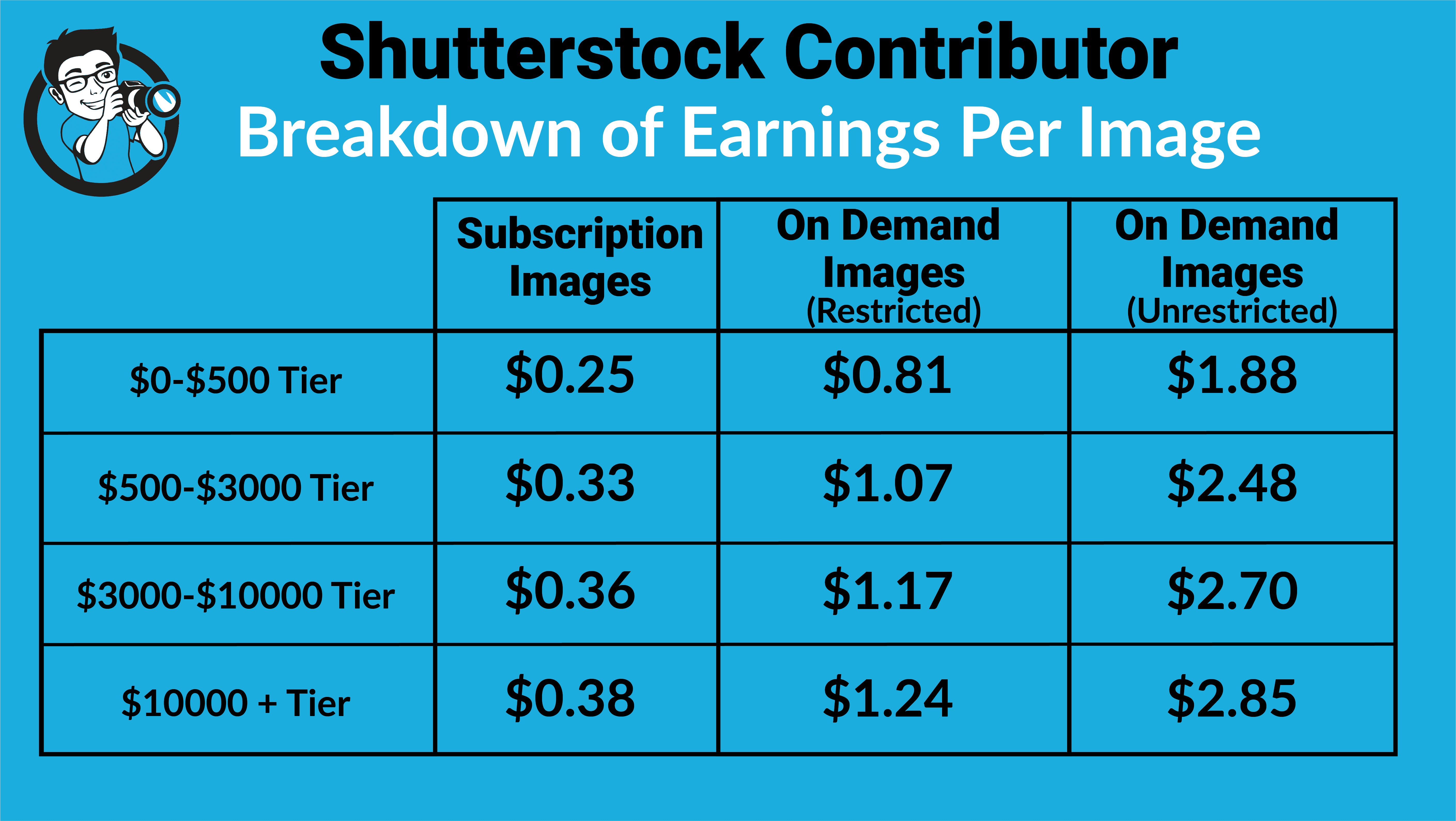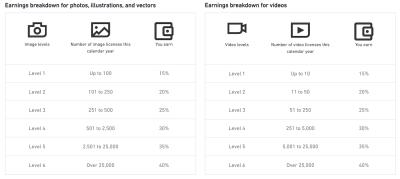Hey there! If you’re a photographer, designer, or artist thinking about contributing to Shutterstock, understanding how their pricing works is super important. Shutterstock’s pricing model is designed to be straightforward but can seem a bit complex at first glance. Basically, it determines how much you earn based on how many downloads your images get, the type of license purchased, and your contributor level. Whether you’re just starting out or you’re a seasoned pro, knowing how the pricing model influences your earnings can help you plan your submissions better and maximize your income. So, let’s break down how it all works!
How Shutterstock Sets Contributor Earnings
Shutterstock’s earnings system is built around a few key factors that influence how much you get paid per download. The good news? They’ve made it transparent so you can see how your earnings grow as you contribute more and get more downloads.
Here’s the basic idea: your earnings per download depend on your contributor level and the type of license purchased. Shutterstock offers different contributor tiers—Standard and Premium—each with its own earning rates and benefits. As you upload more approved images and generate more downloads, you can move up tiers, which means higher earnings per download.
Understanding Contributor Levels
- Standard Contributor: This is the starting point. You earn a base percentage of the download price, which varies depending on your total lifetime earnings and download volume.
- Elite Contributor: Once you hit a certain earning threshold, you qualify for the elite level, which offers increased earnings per download and higher payout rates.
Payment Structure
Shutterstock pays contributors based on a percentage of the sale price, which is influenced by licensing type:
| License Type | Earnings Rate | Description |
|---|---|---|
| Standard License | 25-30% | Most common; covers typical uses like websites, social media, or personal projects. |
| Enhanced License | 30-35% | For broader commercial uses, such as product packaging or advertising campaigns. |
As your total earnings increase, the percentage you receive per download often improves, especially if you move into higher contributor tiers. Additionally, Shutterstock sometimes offers bonuses or special incentives, which can boost your earnings further.
In a nutshell, Shutterstock’s contributor earnings are flexible and rewarding as you build your portfolio and audience. It’s all about growing your reputation, increasing your downloads, and moving up the ranks to earn more per image. Keep contributing, stay consistent, and watch your earnings grow!
Factors Influencing Contributor Royalties and Payouts
When you’re contributing to Shutterstock, it’s natural to wonder what determines how much you earn from each download. Several key factors come into play that influence your royalties and payouts, and understanding these can help you optimize your contributions and income.
1. Contributor Level and Experience: Shutterstock rewards experienced contributors with higher royalty rates. As you submit more approved images and maintain consistent quality, you can move up their contributor tiers. The higher your tier, the larger the percentage you earn per download. So, investing time in creating high-quality content can pay off in increased earnings over time.
2. Download Type and Customer License: Shutterstock offers different licensing options—standard and enhanced. Typically, standard licenses are cheaper and earn you a lower royalty percentage, whereas enhanced licenses are more expensive and often generate higher earnings per download. Also, the type of customer (individual vs. enterprise) can impact payouts, especially if you’re enrolled in programs that reward exclusive content.
3. Contributor Subscription vs. On-Demand Downloads: Shutterstock has both subscription plans (where customers pay a monthly fee for a set number of downloads) and on-demand purchases (where customers buy images individually). Royalties from subscription downloads are generally lower per image, but because subscriptions can lead to higher overall download volume, they can still be a lucrative source of income. On-demand sales tend to be higher per download but may be less frequent.
4. Exclusive vs. Non-Exclusive Content: If your images are exclusive to Shutterstock, you might be eligible for higher royalty rates on some downloads. Non-exclusive content, which is available on multiple platforms, generally earns lower rates per sale but can generate income from multiple sources simultaneously.
5. Geographic Location and Market Demand: Shutterstock’s marketplace is global, and demand varies by region. Popular images in high-demand markets or trending niches can result in more downloads and higher royalties. Keeping an eye on current trends and updating your portfolio accordingly can make a difference.
Understanding these factors helps you see how your contributions fit into the broader picture of earning on Shutterstock. By focusing on quality, strategic keywords, and staying aware of licensing options, you can influence your royalties and maximize your payouts.
Understanding Shutterstock Payment Tiers and Revenue Share
Shutterstock’s payout system is designed to reward contributors based on their experience and contribution volume. Let’s break down how their payment tiers work and what revenue share you can expect at each stage.
Contributor Tiers:
- New Contributor: When you first join Shutterstock, you start at the entry-level tier. Your earnings per download are set at a base rate, which can be increased as you gain more approved downloads.
- Standard Contributor: After reaching a certain number of approved downloads (usually around 50), you move into the standard tier. Here, your royalty rate increases, offering better earnings per sale.
- Elite Contributor: Top-tier contributors, often with thousands of approved downloads and a consistent upload history, reach the elite level. At this stage, you’re eligible for the highest royalty rates Shutterstock offers.
Revenue Share Percentages:
| Contributor Tier | Royalty Rate (Approximate % of Sale Price) | Additional Notes |
|---|---|---|
| New Contributor | 15-30% | Base rate, increases with approved downloads |
| Standard Contributor | 30-40% | Earn more as your portfolio grows |
| Elite Contributor | 40-42% | Highest royalty tier; reserved for top performers |
It’s worth noting that Shutterstock also occasionally offers bonuses or special programs that can boost your earnings further, especially if you’re contributing high-demand content or participating in exclusive deals.
In addition to the percentage-based royalties, Shutterstock pays out on a monthly schedule, typically around the 15th of each month, provided your earnings reach the minimum payout threshold, which is usually $35. The more strategically you upload high-quality, relevant images, the faster you can climb tiers and increase your revenue share.
Understanding these tiers and revenue shares helps you set realistic goals and develop a strategy for growing your Shutterstock contributor career. Remember, consistent quality and quantity are key to moving up the tiers and earning more from your creative work!
Tips to Maximize Earnings as a Shutterstock Contributor
So, you’re ready to boost your income as a Shutterstock contributor? That’s fantastic! Earning more isn’t just about uploading tons of files; it’s about smart strategies that make your portfolio stand out and attract more buyers. Here are some practical tips to help you maximize your earnings:
Focus on Quality Over Quantity
While it might be tempting to upload as many images, videos, or vectors as possible, quality truly wins over quantity. High-resolution, well-composed, and relevant content is more likely to get accepted and purchased. Remember, buyers are looking for assets that meet their specific needs, so investing time in creating standout work pays off.
Research Trending Topics and Niches
Stay ahead by keeping an eye on current trends and popular themes. Use Shutterstock’s search and trend tools to identify what’s in demand. For example, if sustainability or remote work is trending, create content around those topics. Specializing in a niche can position you as an expert and attract dedicated buyers.
Optimize Your Metadata
Effective keywords, titles, and descriptions are your best friends. Use relevant, specific keywords that accurately describe your content. Think about what buyers might search for and include synonyms or related terms. Well-optimized metadata increases your content’s visibility and chances of being purchased.
Upload Consistently
Regular uploads keep your portfolio fresh and increase your chances of being discovered. Set a manageable goal—whether it’s weekly or bi-weekly—and stick to it. Consistency signals activity to Shutterstock’s algorithms, which can help your content get more exposure.
Leverage Analytics
Use Shutterstock’s contributor dashboard to analyze which images or videos perform best. Identify patterns—are certain themes or styles selling more? Use this insight to guide your future creations, focusing on what works and refining your portfolio accordingly.
Engage with the Community
Join Shutterstock contributor forums and social media groups. Sharing experiences, tips, and feedback can inspire new ideas and help you stay motivated. Plus, networking can sometimes lead to collaborations or exclusive opportunities that boost your earnings.
Be Patient and Persistent
Building a successful portfolio takes time. Not every upload will be an instant hit, but persistence and continuous improvement will pay off. Keep uploading, refining your work, and learning from your results. Over time, your efforts will translate into increased sales and higher earnings.
Conclusion and Additional Resources for Contributors
Understanding Shutterstock’s pricing structure and how to navigate it is crucial for making the most of your contributions. Remember, your earnings depend on multiple factors like your content quality, niches you target, and how effectively you optimize your uploads. By focusing on creating high-quality content, staying current with trends, and employing smart metadata strategies, you can steadily grow your income as a contributor.
If you’re serious about maximizing your earnings, don’t forget to keep learning. The digital marketplace is always evolving, and staying informed can give you a competitive edge. Here are some additional resources to help you on your journey:
- Shutterstock Contributor Blog: Regular updates, tips, and case studies.
- Photography and Design Tutorials: Platforms like YouTube, Skillshare, or Udemy offer courses to improve your skills.
- Market Trend Reports: Websites and tools like Google Trends or Adobe Stock Trend Reports can help you identify popular themes.
- Online Communities: Forums like Reddit’s r/StockPhotos or dedicated Facebook groups give a space to ask questions and share experiences.
Remember, success as a Shutterstock contributor is a marathon, not a sprint. Keep honing your craft, stay persistent, and leverage these resources to turn your creativity into a reliable income stream. Happy contributing!


